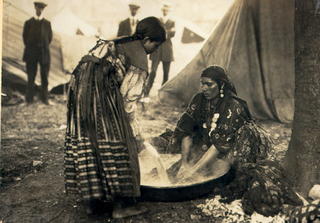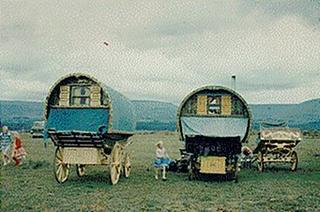The Gypsy Camp - Orientation
Welcome,one and all,to the Gypsy Camp. The Gypsy Chief Lavengro sends you greetings and invites you to take a look around the camp and meet some of the characters here.
You will notice the beautiful setting - the gypsies always appreciate a good `tober' (campground, from the Irish Gaelic, `a well') and this is one of the best. Nestled in a fertile valley not far from the Amazon Queen's Summer Palace,the site boasts Roman Ruins nearby. It has everything a Gypsy wants in a tober - fresh clean running water, whild herbs growing on the hillsides,
and the shelter of trees with spreading branches, where the caravans and tents are set up.
As you enter the camp,if you will look to the right under a grove of trees you will see a magnificent blue and gold painted varda (caravan). It is one of those big square living wagons that you still see on English fairgrounds, called a `palace on wheels' - and that is just what it is because it is the home of our beloved Chief Lavengro. He is usually to be found sitting on the step of his varda, watching over his flock with a fierce but loving gaze. His living wagon is lavishly fitted out inside:

Women visitors always remark on how much he looks like Johnny Depp. Lavengro's mother was Esmeralda, a Spanish gypsy, and one of the most famous flamenco dancers of all time. Her beauty and grace enslaved many men, sheikhs, film stars, even princes - but she turned her back on them all to marry Rory, a wild blue eyed, dark haired Irish Gypsy. Rory was a much respected Gypsy Chief, greatly mourned when he died. He was given the traditional Gypsy burial, his caravan sent up in flames while Esmeralda covered her face with ashes and wailed. Her heart was broken and she did not long outlive him.

Lavengro became Chief in his father's place, not because he was a Chief's son, but because his people love him.
Parked a little further away from the Chief's varda, you will see a small barreltop wagon painted cherry red. This belongs to Lavengro's Aunt Rose, also known as Traveller Rose. She is a highly skilled `dukkerer', or fortune teller, and she often visits the camp to help train the young women in this ancient art.
That wild flamenco music you hear comes from the Gitano camp just across from the Gypsy Chief. These gypsies are Spanish relatives of his that have joined this band of gypsies and regularly keep everyone entertained with their dancing, singing and guitar playing. Flashing eyed maidens sent flirtatious signals to Lavengro as they stamp their heels and click their castanets. The caravans are brightly painted with stars and moons, hung with lanterns and musical instruments.
Fuirther along you will find the Eastern European families - they speak only Romany but are quite willing to help anyone understand the language, as long as they are bona fide Silk Road travellers. This camp is filled with the laughter of children, and the smell of good things cooking.
Nearby are the fabulous tents and ornate caravans of the Silk Road families from India and the Middle East. If curry tempts you, linger here - one of the women will soon have y0u seated with a plateful of steaming curry and rice while you are regaled with songs and stories. Admire the beautiful embroidered silks and woven carpets that they produce.

We are almost back at the Gypsy Chief's varda, when a burst of laughter and song tells us we have reached the Celtic contingent. No use trying to sneak past, they have spotted you and drag you into an impromptu party. Someone shoves a tankard of foaming ale into your hands, asks you if you know the words to Galway Bay and starts singing it anyway.

The welcome you get from the gypsies is heartfelt and welcome - they love the Silk Road travellers and enjoy celebrating all their special occasions, like birthdays, anniversaries and wakes.
Many of the women are skilled dukkerers and when you reach the camp you will meet your own Gypsy Guide and fortune teller, who will read the Tarot cards for you and tell you what you need to know for your journey.
You can stay as long as you like - there are always spare caravans for visitors, and hammocks slung in the trees so you can dream and reflect.
If you happen to spot a small barreltop caravan with a dear old piebald horse called Tinker nearby, please call in and say hello. This is my little home and I always have the kettle on for visitors.
Gail

0 Comments:
Post a Comment
<< Home